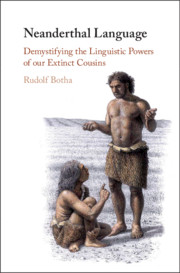Book contents
- Neanderthal Language
- Neanderthal Language
- Copyright page
- Contents
- Figures
- Images
- Acknowledgements
- Copyright Permission for Images
- Part I Preliminaries
- Part II Symbolic Behaviours
- 3 Making and Wearing Personal Ornaments
- 4 Producing Cave Art
- 5 Beautifying Bodies
- 6 Burying the Dead
- 7 Leaping to Language
- Part III Non-symbolic Behaviours
- Part IV Implications
- Notes
- References
- Index
4 - Producing Cave Art
from Part II - Symbolic Behaviours
Published online by Cambridge University Press: 26 April 2020
- Neanderthal Language
- Neanderthal Language
- Copyright page
- Contents
- Figures
- Images
- Acknowledgements
- Copyright Permission for Images
- Part I Preliminaries
- Part II Symbolic Behaviours
- 3 Making and Wearing Personal Ornaments
- 4 Producing Cave Art
- 5 Beautifying Bodies
- 6 Burying the Dead
- 7 Leaping to Language
- Part III Non-symbolic Behaviours
- Part IV Implications
- Notes
- References
- Index
Summary
Chapter 4 elucidates various inferences about Neanderthal language drawn from so-called cave art attributed to Neanderthals. Skeletally, these inferences look as follows, arrows depicting inferential steps: The markings M1,…,Mn are found on the walls of the Iberian caves C1,…,Cn → These markings represent art made by Neanderthal occupants of the caves → This art had a symbolic function for these Neanderthals → These Neanderthals had language. The markings include a hashtag engraving, red disks and hand stencils, a red ladder-shaped sign and red painted mineral deposits. Serious concerns have been expressed about the soundness of these inferences. Two are fundamental. First, the empirical grounding of some are suspect: the dating of the markings is claimed to be inaccurate. This means that some markings may have been made by a modern human rather than a Neanderthal. Second, it has been pointed out, the meanings of the markings are a mystery. This implies that it is unwarranted to infer that these markings were symbols. They could have had a non-symbolic function, which would make the third inferential step ungrounded. Chapter 4 discusses these and other doubts at length.
Information
- Type
- Chapter
- Information
- Neanderthal LanguageDemystifying the Linguistic Powers of our Extinct Cousins, pp. 69 - 82Publisher: Cambridge University PressPrint publication year: 2020
